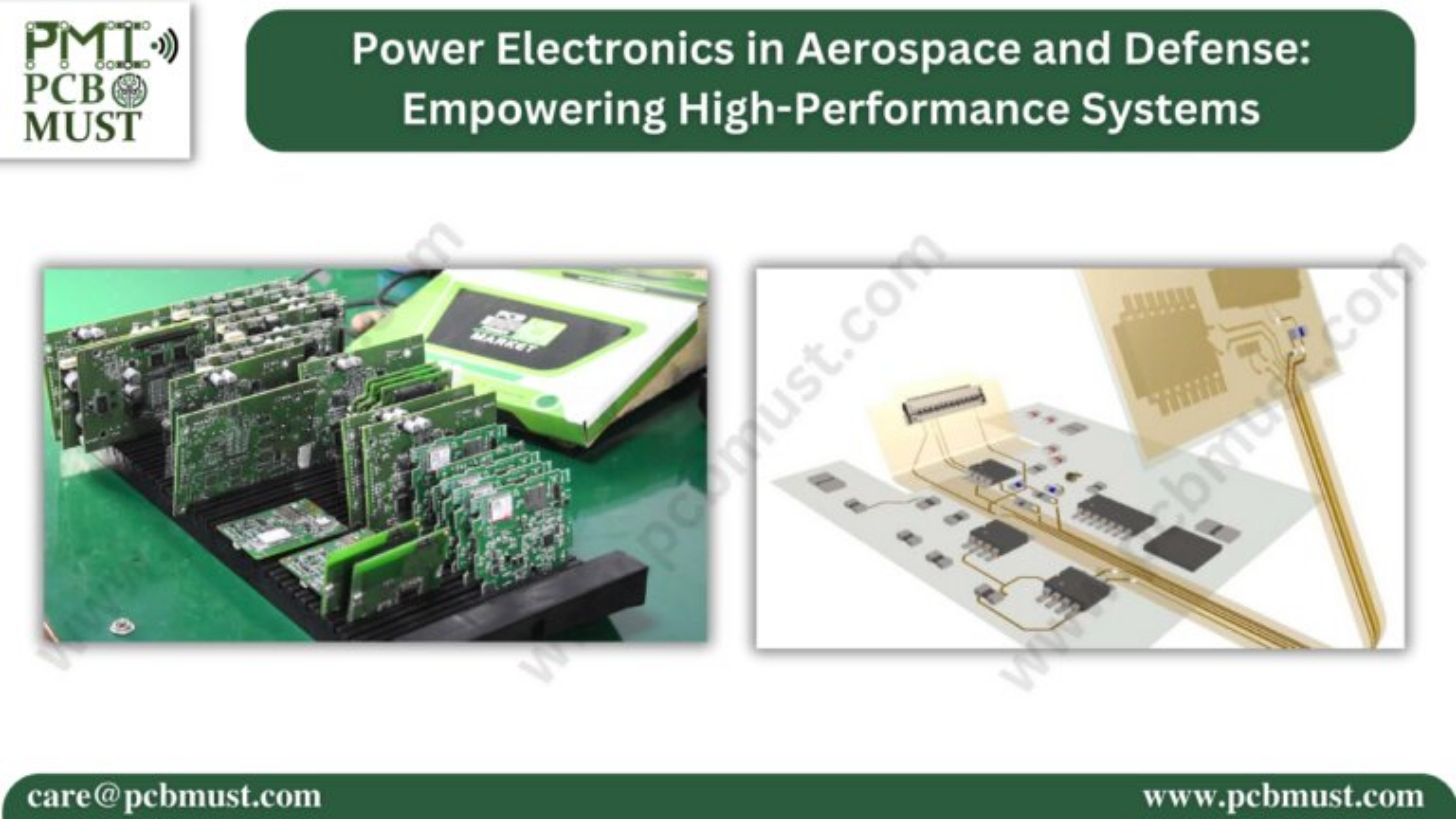-
Power Electronics in Aerospace and Defense: Empowering High-Performance Systems
08/22/2023 at 08:13 • 0 commentsIntroduction:
Power electronics technology plays a critical role in the aerospace and defense industries by enabling efficient power management, control, and conversion in high-performance systems. From aircraft propulsion systems to military vehicles and satellite communications, power electronics empowers the operation and performance of aerospace and defense systems. In this blog, we will explore the significance of power electronics in aerospace and defense applications, its benefits, and other factors that contribute to the advancement of high-performance systems.
![]()
Benefits of Power Electronics in Aerospace and Defense:
1. Efficient Power Conversion: Power electronics enables efficient power conversion in aerospace and defense systems, optimizing energy usage and improving overall system efficiency. By employing power electronic converters, such as inverters and converters, electrical power can be converted from one form to another with minimal losses. Efficient power conversion enhances fuel efficiency, extends mission endurance, and reduces the weight and size of power systems, contributing to improved performance and increased operational range.
2. Motor Control and Drive Systems: Power electronics technology provides precise control over motors and drive systems in aerospace and defense applications. From electric actuators in aircraft control surfaces to propulsion systems in unmanned vehicles, power electronics enables accurate motor control and enhances system responsiveness. Advanced motor control algorithms, coupled with power electronic drives, offer improved efficiency, reliability, and fine-tuned performance characteristics. This level of control is crucial for achieving optimal system operation, reducing maintenance needs, and enhancing overall mission success.
3. Power Quality and Reliability: Power electronics devices, such as uninterruptible power supplies (UPS) and power conditioning units (PCUs), ensure power quality and reliability in aerospace and defense systems. These devices filter out electrical noise, voltage fluctuations, and other power disturbances, providing clean and stable power to critical equipment and sensitive electronics. Power quality and reliability are essential for the operation of navigation systems, communication systems, avionics, and other mission-critical components, ensuring continuous and uninterrupted operation.
4. High Power Density and Lightweight Design: Power electronics advancements have led to the development of high-power density and lightweight systems for aerospace and defense applications. The ability to handle higher power levels within smaller and lighter packages is crucial for reducing weight and maximizing space utilization in aircraft, spacecraft, and military vehicles. Power electronics technologies, such as wide-bandgap semiconductors and advanced cooling techniques, enable the design of compact and lightweight power systems without compromising performance and reliability.
5. Electromagnetic Compatibility (EMC): Power electronics devices are designed with electromagnetic compatibility in mind, ensuring that they do not interfere with or experience interference from other electronic systems. Aerospace and defense applications often involve complex electromagnetic environments, such as radar systems and communication networks. Power electronics systems with effective EMC measures minimize electromagnetic interference (EMI), allowing for reliable and interference-free operation of critical equipment and systems.
Other Factors in Power Electronics for Aerospace and Defense:
1. Thermal Management: Thermal management is a crucial aspect of power electronics in aerospace and defense applications. Power electronics devices generate heat during operation, which needs to be effectively dissipated to maintain optimal performance and reliability. Advanced cooling techniques, such as liquid cooling, heat pipes, and thermal interface...
Read more » -
Sustainable Hardware Design: Reducing Environmental Impact through Innovation
08/21/2023 at 08:17 • 0 commentsIntroduction:
In an era of increasing environmental awareness, sustainable practices have become essential in all aspects of our lives, including technology. Hardware design, which encompasses the development and production of electronic devices, plays a significant role in shaping our environmental impact. Sustainable hardware design focuses on minimizing resource consumption, reducing electronic waste, and incorporating eco-friendly materials and manufacturing processes. By adopting sustainable design principles, hardware designers can contribute to a more sustainable future and help mitigate the environmental impact of electronic devices. In this blog, we will explore the importance of sustainable hardware design, the benefits it brings, and other key factors in reducing the environmental impact of electronic devices.
![]()
Benefits of Sustainable Hardware Design:
1. Reduced Resource Consumption: Sustainable hardware design aims to minimize resource consumption throughout the lifecycle of electronic devices. By adopting efficient circuit designs, low-power components, and power management techniques, designers can optimize energy usage, leading to reduced energy consumption and a smaller carbon footprint. Additionally, sustainable design practices consider the selection and sourcing of materials, prioritizing those with lower environmental impacts and promoting responsible resource management. By reducing resource consumption, sustainable hardware design contributes to the preservation of natural resources and helps combat climate change.
2. Extended Product Lifespan: One of the fundamental principles of sustainability is to extend the lifespan of products. Through thoughtful hardware design, devices can be built to withstand the test of time and resist obsolescence. By using durable materials, modular designs, and providing opportunities for software updates, hardware designers can enhance the longevity of devices. Extending the lifespan of electronic devices reduces the need for frequent replacements, conserves resources, and reduces electronic waste. It also promotes a more sustainable consumer culture by encouraging users to value durability and prioritize repair over replacement.
3. E-Waste Reduction: Electronic waste, or e-waste, is a growing environmental concern. The rapid advancement of technology and the short lifespan of many electronic devices contribute to the accumulation of e-waste globally. Sustainable hardware design aims to reduce e-waste by incorporating design elements that promote recycling, repairability, and responsible disposal. By using easily recyclable materials, minimizing the use of hazardous substances, and implementing take-back programs, hardware designers can facilitate the recycling and proper disposal of devices at the end of their lifecycle. This not only reduces the environmental impact of e-waste but also helps recover valuable materials and reduce the need for raw material extraction.
4. Energy Efficiency: Energy efficiency is a critical aspect of sustainable hardware design. By optimizing circuit designs, selecting energy-efficient components, and implementing power management techniques, hardware designers can reduce energy consumption during device operation. Energy-efficient devices not only contribute to lower electricity bills for users but also reduce the overall demand for energy and the associated environmental impact. Additionally, energy-efficient hardware design extends battery life for portable devices, reducing the need for frequent charging and the disposal of worn-out batteries.
5. Eco-Friendly Materials: Sustainable hardware design promotes the use of eco-friendly materials. Designers can prioritize materials with lower environmental impacts, such as recycled plastics, bio-based materials, and non-toxic substances. By selecting eco-friendly materials, hardware designers reduce the extraction of finite resources, minimize pollution...
Read more » -
The Art of PCB Design: Key Considerations for Hardware Designers
08/18/2023 at 07:02 • 0 commentsIntroduction:
Printed Circuit Board (PCB) design is a critical aspect of hardware design that involves creating the physical layout and interconnections of electronic components. It is often referred to as the “art” of hardware design due to its intricate nature and the significant impact it has on the overall performance, reliability, and manufacturability of electronic devices. In this blog, we will explore the key considerations and best practices that hardware designers should keep in mind when approaching PCB design. From component placement and routing to signal integrity and manufacturability, mastering the art of PCB design is essential for creating successful hardware solutions.
![]()
Benefits of Effective PCB Design:
1. Signal Integrity and Performance: A well-designed PCB layout plays a crucial role in maintaining signal integrity and ensuring optimal performance of electronic circuits. Careful consideration of trace routing, signal paths, and ground planes helps minimize signal interference, crosstalk, and noise. By optimizing signal integrity, hardware designers can achieve faster data transfer rates, reduced latency, and improved overall performance of electronic devices.
2. Thermal Management: Efficient thermal management is essential for the reliable operation of electronic components. PCB design factors such as component placement, thermal vias, and copper planes influence the dissipation of heat generated during operation. By implementing proper thermal design techniques, hardware designers can prevent overheating, extend the lifespan of components, and enhance the overall reliability of the device.
3. Miniaturization and Space Optimization: With the continuous demand for smaller and more compact electronic devices, PCB design plays a critical role in achieving miniaturization and space optimization. By carefully arranging components, employing multilayer PCBs, and utilizing surface mount technology (SMT), hardware designers can maximize the utilization of available space, enabling sleek and compact devices without compromising functionality.
4. Electromagnetic Compatibility (EMC): EMC is the ability of electronic devices to operate without causing interference or being susceptible to interference from other devices. Effective PCB design helps ensure electromagnetic compatibility by employing proper grounding techniques, minimizing loop areas, and separating sensitive analog and digital components. By addressing EMC considerations during PCB design, hardware designers can minimize the risk of electromagnetic interference (EMI) and enhance the overall reliability and performance of the device.
5. Manufacturability and Cost Optimization: A well-designed PCB layout takes into account manufacturability and cost optimization. Design considerations such as component availability, ease of assembly, and efficient production processes help reduce manufacturing costs and minimize the time-to-market. Collaboration with manufacturers during the design phase facilitates the smooth transition from prototype to mass production, ensuring high-quality and cost-effective manufacturing.
Other Factors in PCB Design:
1. Component Placement and Routing: Careful component placement is crucial for optimal signal integrity, thermal management, and space optimization. Placing components in close proximity to minimize trace lengths reduces signal propagation delays and improves performance. Hardware designers must also consider factors such as power and ground plane placement, decoupling capacitors, and proper routing techniques to minimize noise and interference. Additionally, the layout should consider accessibility for assembly and repair, as well as comply with safety and clearance requirements.
2. Layer Stackup and Routing Strategy: The layer stackup and routing strategy are key considerations in PCB design. Deciding the number of layers,...
Read more »
My Pages
Projects I Like & Follow
Share this profile
ShareBits
Become a Hackaday.io Member
Create an account to leave a comment. Already have an account? Log In.
 Avi Gupta
Avi Gupta


 Lutetium
Lutetium